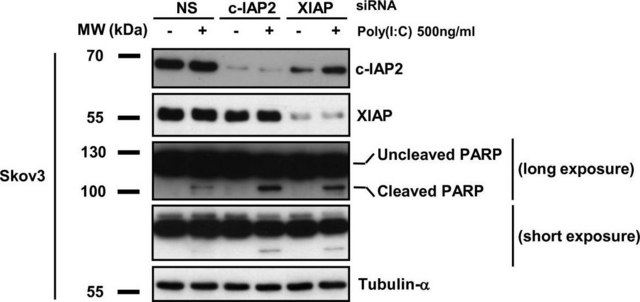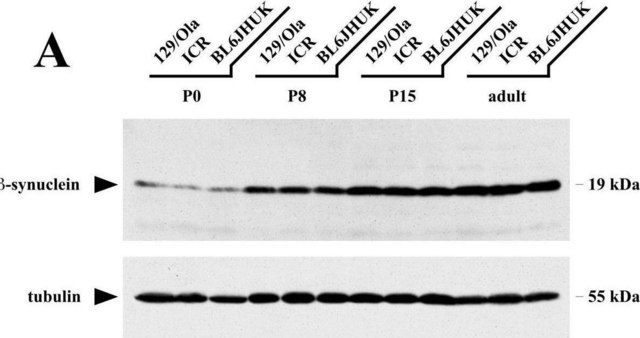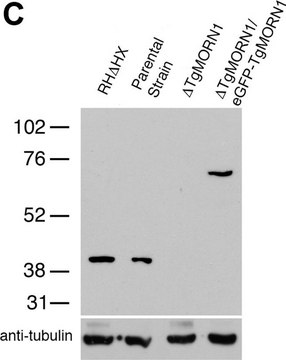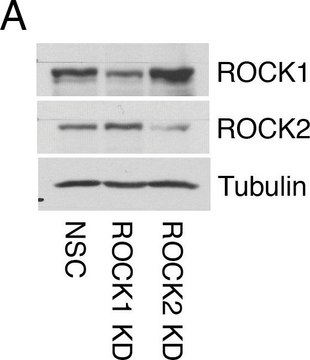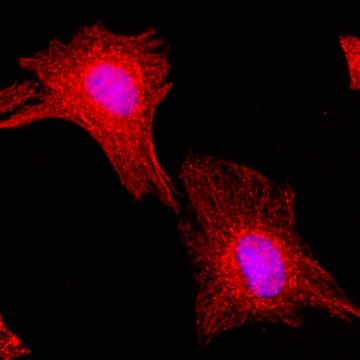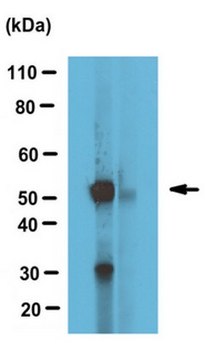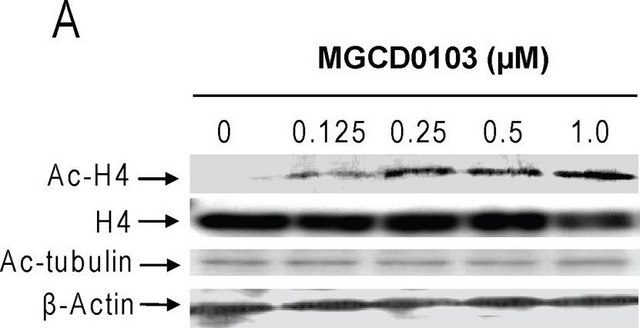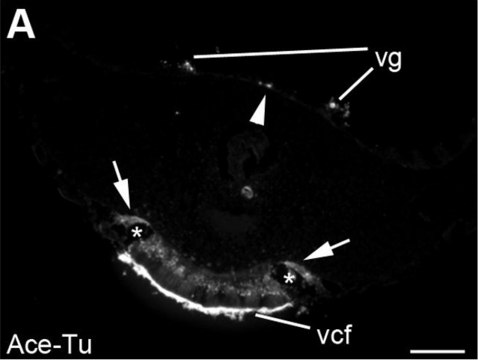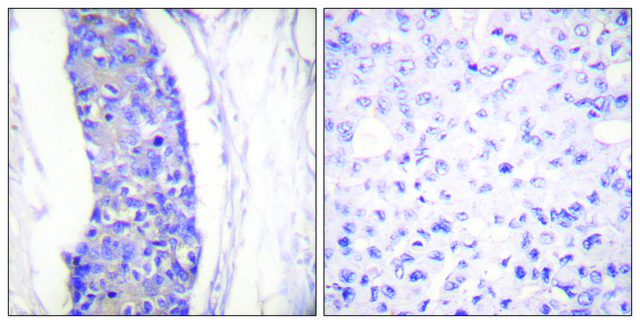ABT170
Anti-alpha Tubulin Antibody, nontyrosinated
serum, from rabbit
Sign Into View Organizational & Contract Pricing
All Photos(1)
Synonym(s):
Tubulin alpha-1A chain, Alpha-tubulin 3, Tubulin B-alpha-1, Tubulin alpha-3 chain
UNSPSC Code:
12352203
eCl@ss:
32160702
NACRES:
NA.41
Recommended Products
biological source
rabbit
Quality Level
antibody form
serum
antibody product type
primary antibodies
clone
polyclonal
species reactivity
mouse, porcine
species reactivity (predicted by homology)
rat (based on 100% sequence homology), human (based on 100% sequence homology)
technique(s)
ELISA: suitable
immunocytochemistry: suitable
western blot: suitable
NCBI accession no.
UniProt accession no.
shipped in
wet ice
target post-translational modification
unmodified
Gene Information
human ... TUBA1A(7846)
General description
Microtubules are involved in a wide variety of cellular activities ranging from mitosis and transport events to cell movement and the maintenance of cell shape. Tubulin itself is a globular protein which consists of two polypeptides (alpha and beta tubulin). Alpha and beta tubulin dimers are assembled to 13 protofilaments that form a microtubule of 22 nm diameter. Tyrosine ligase adds a C-terminal tyrosin to monomeric alpha tubulin. Assembled microtubules can be detyrosinated by a cytoskeleton associated carboxypeptidase. Detyrosinated alpha tubulin is referred to as Glu-tubulin. Another post-translational modification of detyrosinated alpha tubulin is C-terminal polyglutamylation which is characteristic for microtubules in neuronal cells and the mitotic spindle.
Specificity
This antibody detects the nontyrosinated form of alpha Tubulin.
Immunogen
KLH-conjugated linear peptide corresponding to human nontyrosinated alpha Tubulin.
Application
Detect Tubulin using this rabbit polyclonal antibody, Anti-alpha Tubulin Antibody, nontyrosinated validated for use in western blotting, ELISA & ICC.
Research Category
Cell Structure
Cell Structure
Research Sub Category
Cytoskeleton
Cytoskeleton
Western Blotting Analysis: A representative lot from an independent laboratory specifically detected nontyrosinated alpha Tubulin and not tyrosinated alpha Tubulin from purified porcine alpha Tubulin (Gundersen, G. G., et al. (1984). Cell. 38(3):779-89.).
ELISA Analysis: A representative lot from an independent laboratory specifically detected nontyrosinated alpha Tubulin, and not nontyrosinated alpha Tubulin in an indirect ELISA and in a competitive ELISA (Gundersen, G. G., et al. (1984). Cell. 38(3):779-89.).
Immunocytochemistry Analysis: A representative lot from an independent laboratory specifically detected nontyrosinated alpha Tubulin, and not nontyrosinated alpha Tubulin in TC-7 cells in interphase (Gundersen, G. G., et al. (1984). Cell. 38(3):779-89.).
ELISA Analysis: A representative lot from an independent laboratory specifically detected nontyrosinated alpha Tubulin, and not nontyrosinated alpha Tubulin in an indirect ELISA and in a competitive ELISA (Gundersen, G. G., et al. (1984). Cell. 38(3):779-89.).
Immunocytochemistry Analysis: A representative lot from an independent laboratory specifically detected nontyrosinated alpha Tubulin, and not nontyrosinated alpha Tubulin in TC-7 cells in interphase (Gundersen, G. G., et al. (1984). Cell. 38(3):779-89.).
Quality
Evaluated by Western Blotting in NIH/3T3 cell lysate, which were untreated or treated with Pancreatic Carboxypeptidase (PCA).
Western Blotting Analysis: A 1:2,000 dilution of this antibody detected alpha Tubulin, nontyrosinated in 10 µg of PCA treated NIH/3T3 cell lysate and demonstrated a loss of signal in untreated NIH/3T3 cell lysate.
Western Blotting Analysis: A 1:2,000 dilution of this antibody detected alpha Tubulin, nontyrosinated in 10 µg of PCA treated NIH/3T3 cell lysate and demonstrated a loss of signal in untreated NIH/3T3 cell lysate.
Target description
~51 kDa observed
Linkage
Replaces: 04-1117
Physical form
Rabbit polyclonal serum in buffer containing serum with 0.05% sodium azide.
Unpurified
Storage and Stability
Stable for 1 year at -20°C from date of receipt.
Handling Recommendations: Upon receipt and prior to removing the cap, centrifuge the vial and gently mix the solution. Aliquot into microcentrifuge tubes and store at -20°C. Avoid repeated freeze/thaw cycles, which may damage IgG and affect product performance.
Handling Recommendations: Upon receipt and prior to removing the cap, centrifuge the vial and gently mix the solution. Aliquot into microcentrifuge tubes and store at -20°C. Avoid repeated freeze/thaw cycles, which may damage IgG and affect product performance.
Disclaimer
Unless otherwise stated in our catalog or other company documentation accompanying the product(s), our products are intended for research use only and are not to be used for any other purpose, which includes but is not limited to, unauthorized commercial uses, in vitro diagnostic uses, ex vivo or in vivo therapeutic uses or any type of consumption or application to humans or animals.
WGK
WGK 1
Certificates of Analysis (COA)
Search for Certificates of Analysis (COA) by entering the products Lot/Batch Number. Lot and Batch Numbers can be found on a product’s label following the words ‘Lot’ or ‘Batch’.
Already Own This Product?
Find documentation for the products that you have recently purchased in the Document Library.
Hui Li et al.
Frontiers in psychiatry, 9, 588-588 (2018-11-30)
Estrogen (E2) withdrawal is a core pathology mechanism for postpartum depression (PPD). Galanin (GAL), an estrogen-inducible neuropeptide has also been reported to be associated with depression. However, it still remains unclear which GAL receptors (GALRs) are involved in PPD pathologic
Lei Feng et al.
Developmental biology, 395(2), 268-286 (2014-09-23)
L-fucose, a monosaccharide widely distributed in eukaryotes and certain bacteria, is a determinant of many functional glycans that play central roles in numerous biological processes. The molecular mechanism, however, by which fucosylation mediates these processes remains largely elusive. To study
Saifeng Cheng et al.
Cell, 185(17), 3169-3185 (2022-08-01)
Mice deficient for all ten-eleven translocation (TET) genes exhibit early gastrulation lethality. However, separating cause and effect in such embryonic failure is challenging. To isolate cell-autonomous effects of TET loss, we used temporal single-cell atlases from embryos with partial or
Marko Dunjić et al.
Nature communications, 14(1), 3791-3791 (2023-06-27)
Eviction of histones from nucleosomes and their exchange with newly synthesized or alternative variants is a central epigenetic determinant. Here, we define the genome-wide occupancy and exchange pattern of canonical and non-canonical histone variants in mouse embryonic stem cells by
Histone deacetylase inhibitors (HDACi) increase expression of KCa2.3 (SK3) in primary microvascular endothelial cells.
Kolski-Andreaco, et al.
American Journal of Physiology. Cell Physiology, 322, C338-C353 (2023)
Our team of scientists has experience in all areas of research including Life Science, Material Science, Chemical Synthesis, Chromatography, Analytical and many others.
Contact Technical Service